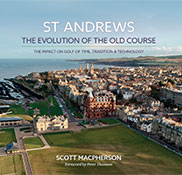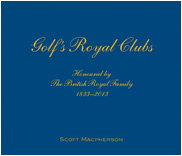GOLF CHAMPIONSHIPS ON SMGD COURSES:
At Close House – Colt Course. Sept 2017. A prestigious European Tour Championship hosted by Lee Westwood.
Broadcast worldwide from Royal Wellington Golf Club, NZ. October 2017. WOW!
The legacy continues.
Co-hosted at the award-winning Millbrook Resort near Queenstown, NZ. 2014 – 2023.
Future Greens
In 1891 Dr J.G. McPherson, a keen golfer from St Andrews wrote of the greens, ‘there was a variety of surface which brought out the greater skill; now all are nicely turfed over and artificially dressed like billiard tables. Then, at the Heather Hole one had to dodge about and watch the lie of the green… Now, a dead straight putt suffices. The Sandy Hole puzzled the uninitiated with its heavy putting surface; now it is a stroke easier.’ The Old Course received no attention in these earliest days and the only greenkeepers were the rabbits. It is therefore one of the greatest transformations in golf that courses now double cut and roll greens with the aim of establishing uniformly smooth and fast greens of the same colour. There has been a slight drift away from having greens green, focusing more on having them healthy, but the fascination for speed and smoothness has accelerated. What does the future hold?
Golf greens in the future may be a combination of tradition and technology. Preparing greens to varying speeds- depending on their slope- may allow tournament officials to provide a better test of modern golfers putting skills. As such, a drift back to non-uniformity can be recommended.
Early 1900’s greens matched the slower surface condition of the grass and averaged slopes of 5 percent to 8 percent. This amount of pitch was considered fair play when cut to speeds of perhaps 3-6 feet by the greens mowers of that time period. Because of this variability, the predominant reason for a practice rounds prior to the Open was to learn each greens ‘personality’. The challenge of putting was to remember which green was faster or slower, and which side to approach the flag to get the smoothest line to the hole.
At St Andrews, while the turf condition and maintenance equipment has improved, the contours in the greens have not been altered since Old Tom is said to have ‘levelled the putting greens by the terracing up of their lower edges’ in the late 1800’s. As a result, some areas of most greens are unsuitable for modern pin positions- E.g. 11th green. At 4-6%, much of it is too steep for a flag location- especially in the Open Championship when the greens are running at 10+ feet on the stimpmeter. Simply, a ball will never come to rest. However, if green speeds were varied and slowed on the more undulating greens, more pin positions would be made available. Indeed, on this green at a speed of say 8, the exciting left side of the green could be used- which would bring ‘Hill bunker’ into play! Cricket provides a good analogy. Each green would be like facing a good quick bowler. The golfers job would be to the pick the line, judge the movement and guess the speed!
Caption- The traditional modern pin position for the Open Championship on this green is either back right or just over ‘Strath’ bunker. Occasionally the pin may be located on the left side of the green during or casual play when the greens are running slower, but not during the Open. With greens running at speeds of 10+ on the stimpmeter, it has been found that a ball will not come to rest on areas on firm tight bentgrass greens with a slope of greater than 3% slope.
An eagerness for speed and uniformity in our greens has reduced putting to a more monochromatic art. To enhance it, limit compaction, and reuse some of the more interesting areas on our greens, the speed of greens could in the future be purposefully varied. Such a scheme is not contrary to the concept of progress, in fact the exact opposite. Future golfers will need the fine touch required on quick greens, the skill previous generations had to negotiate slower undulating greens and the memory to remember which are which!
AWARDS
 Winner
Winner
Excellence in Compliance Award
Royal Wellington Golf Club
 Scott awarded by GEO as a Sustainable Golf Champion
Scott awarded by GEO as a Sustainable Golf Champion
PUBLICATIONS
 St Andrews
St Andrews
The Evolution of the Old Course
by Scott Macpherson
TESTIMONIALS
"During both the design and construction phases their can-do attitude to problem solving was refreshing".
Ben O'Malley, Millbrook Country Club, NZ




